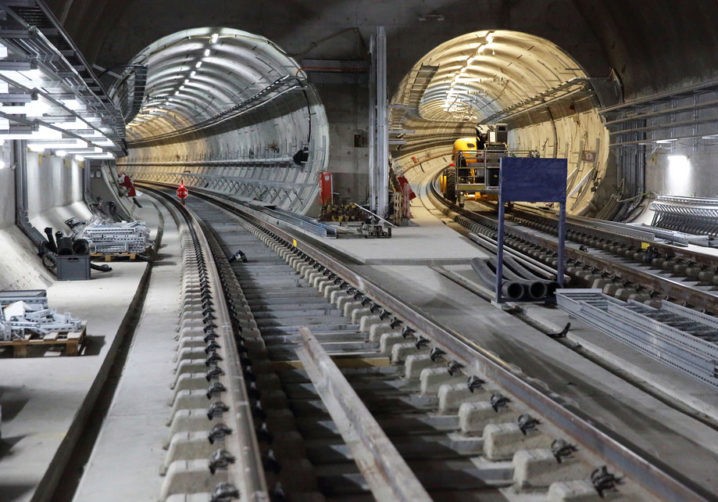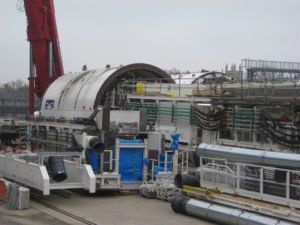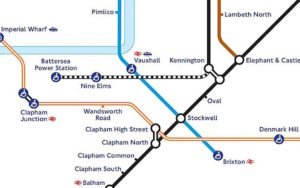SHP caught up with Ian Raxton, HM Principal Inspector of Railways at Office of Rail and Road, and Louise Ellary CMIOSH, Health and Safety Leader, Laing O’Rourke to find out how safety is manged on some of the UK’s major rail projects.

The Office of Rail and Road covers mainline railways in the UK, and other rail systems including London Underground and tramways. As an independent regulator, it operates within the framework set by UK and EU legislation and is accountable through Parliament and the courts.
This can be anything from ‘run of the mill’ projects like bridge replacements, to larger new projects such as HS2 and Crossrail, where there hasn’t been an existing railway or railway operation. Those projects initially fall under the HSE’s remit, until they become railway, but ORR has an agreement to be involved in the design phase with a view to taking over when the job becomes an operating railway in the future.
Some of the regular maintenance tasks regulated by ORR include things such as earthworks, bridge and viaduct reconditioning, re-signalling and electrification upgrades of sections of railway. It also oversees major tram expansions such as in Manchester and Birmingham for example.
ORR inspectors are out on the network every day and step in to take enforcement action when they find safety failings, as well as encouraging projects to adopt good practice and innovation.
Challenges
Ian explained that due to the long, linear nature of many of the developments being worked on, sites are often spread across long geographical routes, often away from cities and roads, so getting access and moving materials can be an issue. A lot of planning is required, and sometimes temporary access needs to be built, to get to the trackside locations. Ian mentioned that on one project on one project, it was simpler to construct a new permanent road first, to enable access to the railway.
Once access is achieved, delivery of materials and the work itself, needs to fit in around timetables. For that reason, much of the work is carried out at night, at weekends and during public holidays such as Christmas, as operators look to restrict closures to the minimum time.
Competency
One of the initiatives being used by Network Rail and Transport for London is its Sentinel card, which uses ID cards to record the competencies of staff and monitor their access to worksites. It relies on a competency framework with training courses for workers that range from basic understanding of dangers of working on the railway through to more specialist skills. The Sentinel system has been evolving since being introduced in 1999 and, since 2016, also now helps contractors to control fatigue – stopping workers from finishing up on one job and going straight on to another contract later that day without the necessary rest. The card allows workers’ competence and fitness to work to be verified simply and effectively in near real time.
Crossrail

Crossrail tunnel boring maching
Now currently at the ‘fitting-out’ phase, Crossrail has been a hugely challenging project right from the beginning. The latest addition to the underground network, which will be known as the Elizabeth Line when complete, has seen work spread across 40 London sites. Some of the challenges included asbestos-handling during demolition and enabling works, the construction risks involved when tunnelling, excavating and creating new stations, and the logistical issues of safely moving millions of tonnes of excavated materials through a busy city centre.
According to Crossrail, health and safety is not referred to as a priority. “Priorities can change from day-to-day to ensure work is delivered on time and within funding. Instead, Health and Safety is the ‘number one value’. The Target Zero principles are clear: everyone has the right to go home unharmed and all harm is preventable. Crossrail’s 6 pillars of Target Zero are rolled down into the supply chain.”
The project has seen a particular focus on health and wellbeing though, with ‘every effort made to raise the bar across the industry’.
https://www.youtube.com/watch?v=eRzWqtNpeC4
Northern Line Extension
Louise Ellary CMIOSH, is the Health and Safety Leader at Laing O’Rourke, overseeing Northern Line Extension work. Louise is an advocate of the Safety Differently model, delivering a complex scope with some great innovation.
 The new part of the line, an off-shoot from Kennington, has seen two new stations constructed at Nine Elms and Battersea Power Station. All tunnelling work is now complete, and the team have reached the fit-our stage.
The new part of the line, an off-shoot from Kennington, has seen two new stations constructed at Nine Elms and Battersea Power Station. All tunnelling work is now complete, and the team have reached the fit-our stage.
Louise is overseeing work at three main locations and manages a health and safety manager in each of those sites. One of the main challenges was working in such built up and heavily congested areas of the city. A Comms team and an Environment team were appointed in conjunction with the client, London Underground, to maintain engagement with the residents, whose main concern was noise during tunnelling. As a result, noise monitors were installed at key locations throughout the sites and noise levels were always assessed and fed back to the communities.
Two types of tunnelling have been used on the construction, spray concrete lining tunnelling and concrete boring tunnelling. Much of the work was very challenging as the team was tunnelling around the existing Northern Line for around a year, while it was in still operation, before breaking out into the existing tube over the Christmas period last year.
Louise was also keen to reiterate the key to strong safety with the many contractors on the project is a lot of engagement. Safety start-up meetings are held with all contractors and the contractors commit to “do as we do”.
The senior team also host bi-weekly meetings with engineers, supervisors and the client, to review all upcoming activities, if there are any high-risk activities and what needs to be done make sure everything is ready. They make provisions around what would happen if something went wrong and highlight anything that is working well, things that are not and anything that can be done to improve. “It’s all about collective insight, with workgroups brought in to look at all methodology,” Louise added.
Micro experiment is the vehicle being used to make this happen. Most ideas don’t work the first time you use them, so micro experiments make failure more manageable and allow the workforce to become involved in the process.
Glasgow Subway
Earlier this year, civil engineering firm Freyssinet, was presented with the Risk Reduction through Design Award for its work on Glasgow Subway at the HSE Work-Related Musculoskeletal Disorder summit. Tasked with repairing 10km of tunnels, with very restricted access, the firm was recognised for developing a number of innovative methods to facilitate the works, and to ensure the safety of its employees, subcontractors and the general public during the three years on site.
Freyssinet opted to order 160,000 25kg grouting sacks, rather than having it delivered to the site by the truck load. The firm then built a series of mechanical overhead conveyors to transport the grout into the tunnels, mitigating the need for manual handling, and a bespoke drilling rig, which could be operated from the ground, reducing the amount of working at height required and lessening potential exposure to dust and vibration.
Safety culture
Ian noted that safety culture is now considerably improved within the rail industry and that has come a long way in the last 30 years, with a big reduction in ‘basic accidents’: “Railway safety has a very strong culture of ‘do it right’, speak if you have concerns. Improving the perception of construction is key. Some of the long testing and commissioning periods you see in projects such as Crossrail are often to ensure that projects are ‘right’ as soon as they go into service.”
He suggested that the culture of wanting to avoid the negative effects of things going wrong in service by rushing to meet deadlines had to be accompanied by a willingness to accept the bad press that goes with those delays to handing back the railway. This acceptance of responsibility and commitment to high standards has to come from the top; “You need full commitment from the board in situations like this and it has to be driven down through management.” A company’s culture comes from the senior leaders – they need to set the tone for performance.
This eBook will guide you through some of the key understandings you need to be able to manage driver safety effectively and, at the end, provide a series of free resources you can access to help you ensure your own driver safety management system is robust, legally compliant and in line with industry-accepted good practice.
Download this eBook from Driving for Better Business and SHP to cover:
- Why do we need to manage driver safety?
- Duty of care – a shared responsibility;
- Setting the rules with a driving for work policy;
- Managing driver safety;
- Ensuring safe vehicles;
- Safe journeys and fitness to drive;
- Record keeping;
- Reporting;
- The business benefits of good practice;
- Additional resources



 The new part of the line, an off-shoot from Kennington, has seen two new stations constructed at Nine Elms and Battersea Power Station. All tunnelling work is now complete, and the team have reached the fit-our stage.
The new part of the line, an off-shoot from Kennington, has seen two new stations constructed at Nine Elms and Battersea Power Station. All tunnelling work is now complete, and the team have reached the fit-our stage.